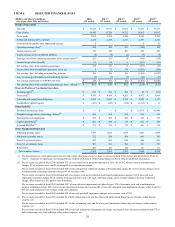Albertsons 2016 Annual Report Download - page 25
Download and view the complete annual report
Please find page 25 of the 2016 Albertsons annual report below. You can navigate through the pages in the report by either clicking on the pages listed below, or by using the keyword search tool below to find specific information within the annual report.23
suppliers, transportation interruptions, labor supply or stoppages or vendor defaults or disputes, as well as other risk factors
mentioned, any of which could also have an adverse effect on the Company’s sales and operating results. Disruptions to the
national and international transportation infrastructure that lead to delays or interruptions of deliveries could also negatively
affect the Company’s business.
Changes in the military commissary system or decreases in governmental funding could negatively impact the sales and
operating performance of the Company’s military business.
The Company’s Wholesale segment sells and distributes grocery products to military commissaries and exchanges in the United
States. The Company’s military business faces competition from large national and regional food distributors as well as smaller
food distributors. Due to the narrow operating margins in the military food distribution industry, it is of critical importance for
distributors to achieve economies of scale. Any material changes in the commissary system, the level of governmental funding
to the Defense Commissary Agency (“DeCA”), military staffing levels, or the locations of bases may have a corresponding
impact on the sales and operating performance of the Company’s military business. Mandated reductions in government
expenditures, including those imposed as a result of sequestration, may impact the level of funding to the DeCA and could have
a material impact on the Company’s operations.
The Company’s insurance and self-insurance programs may not be adequate to cover future claims.
The Company uses a combination of insurance and self-insurance to provide for potential liabilities for workers’ compensation,
automobile and general liability, director and officer liability, property risk, cyber and privacy risks and employee healthcare
benefits. The Company estimates the liabilities associated with the risks retained by the Company, in part, by considering
historical claims experience, demographic and severity factors and other actuarial assumptions, which, by their nature, are
subject to a degree of variability. Any actuarial projection of losses concerning workers’ compensation and general and
automobile liability is subject to a degree of variability. Among the causes of this variability are unpredictable external factors
affecting future inflation rates, discount rates, rising health care costs, litigation trends, legal interpretations, benefit level
changes and actual claim settlement patterns. For example, the Company believes that its insurance coverage will mitigate the
financial impact of the criminal intrusions to the Company’s information technology systems that it experienced in fiscal 2015;
however, the Company cannot be certain that its coverage will fully mitigate the financial impact of the intrusions or that such
coverage will not be disputed.
Some of the many sources of uncertainty in the Company’s reserve estimates include changes in benefit levels, medical fee
schedules, medical utilization guidelines, vocation rehabilitation and apportionment. If the number or severity of claims for
which the Company is self-insured increases, or the Company is required to accrue or pay additional amounts because the
claims prove to be more severe than the Company’s original assessments, the Company’s financial condition and results of
operations may be adversely affected.
Volatility in fuel and energy costs and risk associated with the Company’s compressed natural gas program could
adversely affect the Company’s results of operations.
The Company’s operations are dependent on the availability of a significant amount of energy and fuel to store and transport
products. Energy and fuel costs are influenced by supply as well as international, political and economic circumstances and
have experienced volatility over time. To reduce the impact of volatile fuel and energy costs, the Company has entered into
contracts to purchase fuel, electricity and natural gas at fixed prices to satisfy a portion of its expected needs. Additionally, the
Company has invested in approximately 60 semitrailer trucks powered by compressed natural gas. In the recent past, the price
of natural gas has been volatile, and this volatility may continue. Additionally, having compressed natural gas equipment and a
fueling station entails inherent risks, including equipment defects, malfunctions and failures and natural disasters, which could
result in flows of natural gas, fires, explosions and other damages, and could subject the Company to additional regulation.
Volatility in fuel and energy costs that exceeds offsetting contractual arrangements, or failure to recognize the anticipated
benefits from the compressed natural gas program, could adversely affect the Company’s results of operations.
























